 A whole bunch of photos of yesterdays snorkel at Castle Beach. The viz has cleared up, although nothing like the fabled June 2017 viz, will it ever be as good again?! (see here). There are lots of yellows and browns, some greens, a substantial dash of blue of the rainbow wrack but hardly any reds and purples at this time of year. The glow of the sun exarcerbates the yellowish vibe, but somehow I suspect the colour temperature of the Olympus somehow is a bit off compared to my old Canon. I am not entirely sure about this though, and in theory this is all correctable postprocessing, I just don’t know how!
A whole bunch of photos of yesterdays snorkel at Castle Beach. The viz has cleared up, although nothing like the fabled June 2017 viz, will it ever be as good again?! (see here). There are lots of yellows and browns, some greens, a substantial dash of blue of the rainbow wrack but hardly any reds and purples at this time of year. The glow of the sun exarcerbates the yellowish vibe, but somehow I suspect the colour temperature of the Olympus somehow is a bit off compared to my old Canon. I am not entirely sure about this though, and in theory this is all correctable postprocessing, I just don’t know how! 


 The photo below shows some of the common species, from the bottom right to top left: Cladostephus spongiosus, Dictyota dichotoma, Asparagopsis armata, Cystoseria baccata with Sargassum muticum in the background. Ij the second photo it is obvious that the Wireweed and Rainbow wrack are quite dominant, same for the Hairy sandweed Cladostephus spongiosus. The Thong (or Spaghetti) weed is covered in fuzzy epiphytes. I will keep practicing for when the reds and purples come back in autumn!
The photo below shows some of the common species, from the bottom right to top left: Cladostephus spongiosus, Dictyota dichotoma, Asparagopsis armata, Cystoseria baccata with Sargassum muticum in the background. Ij the second photo it is obvious that the Wireweed and Rainbow wrack are quite dominant, same for the Hairy sandweed Cladostephus spongiosus. The Thong (or Spaghetti) weed is covered in fuzzy epiphytes. I will keep practicing for when the reds and purples come back in autumn! 

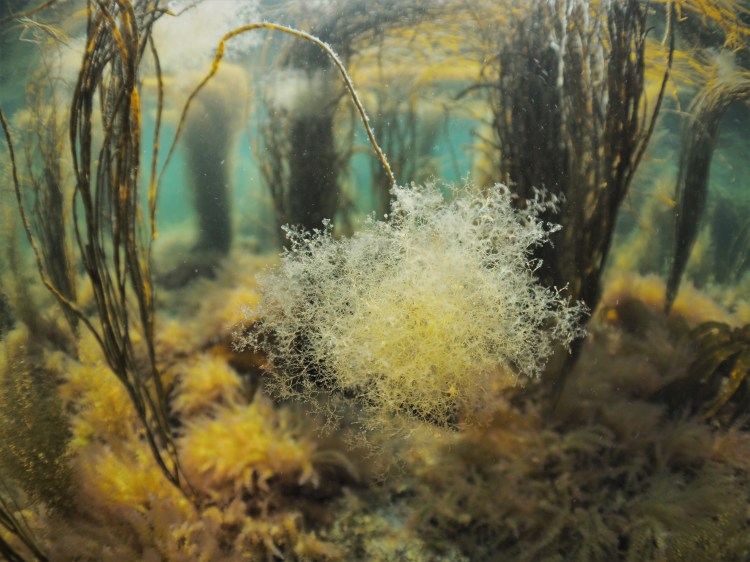
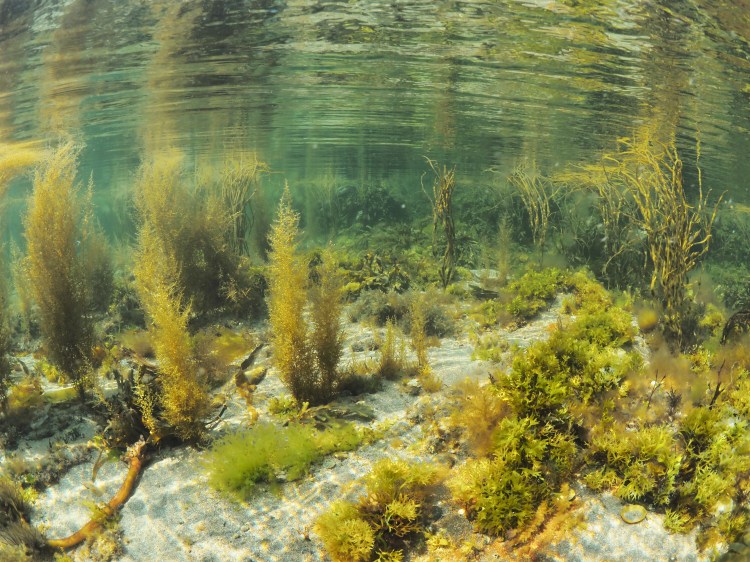

Tag Archives: Sargassum muticum
Falmouth Seaweeds October
 To my regret I did not manage to take a look at the seaweeds at Castle Beach in September (it was my aim to go in at least once every month). Last Friday however, the sun was shining, the wind was gone and the tide was low (and I was able to escape work) so I at least could make October. Not only was the viz excellent, to my surprise, the seaweeds looked very healthy. It seems that there is a second, autumn seaweed bloom that I was not aware of. Some of the bleached corraline algae have regained their pink colour, the Harpoon weed Asparagopsis armata increased in abundance and I saw species such as Red grape weed Gastroclonium ovatum growing again. The Bushy rainbow wrack has partly died back, forming dense, dark-brown mats (fourth photo) but also show fresh growth. This species is covered in many epiphytes such as Brown fan weed Dictyota dichotoma, and remnants of Bull huss mermaid’s purses still cling on. Interestingly, Wireweed Sargassum muticum has almost completely disappeared.
To my regret I did not manage to take a look at the seaweeds at Castle Beach in September (it was my aim to go in at least once every month). Last Friday however, the sun was shining, the wind was gone and the tide was low (and I was able to escape work) so I at least could make October. Not only was the viz excellent, to my surprise, the seaweeds looked very healthy. It seems that there is a second, autumn seaweed bloom that I was not aware of. Some of the bleached corraline algae have regained their pink colour, the Harpoon weed Asparagopsis armata increased in abundance and I saw species such as Red grape weed Gastroclonium ovatum growing again. The Bushy rainbow wrack has partly died back, forming dense, dark-brown mats (fourth photo) but also show fresh growth. This species is covered in many epiphytes such as Brown fan weed Dictyota dichotoma, and remnants of Bull huss mermaid’s purses still cling on. Interestingly, Wireweed Sargassum muticum has almost completely disappeared. 
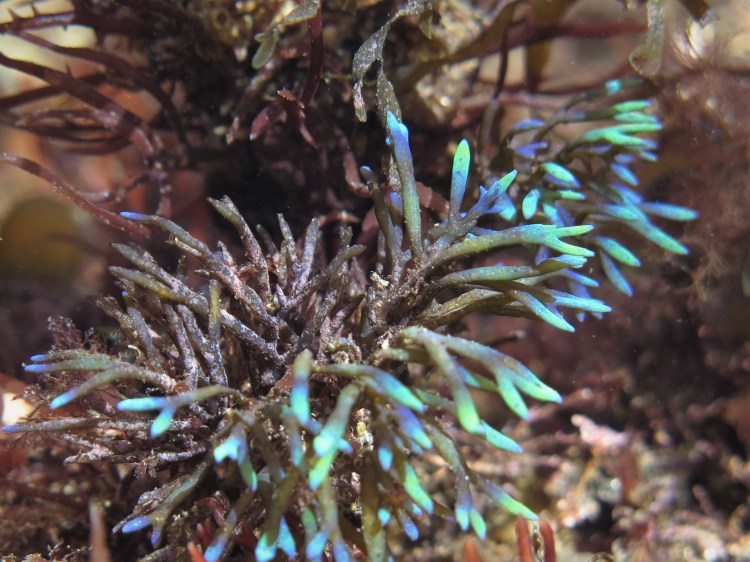
 It is tricky photographing rock pool seaweeds. One main issue is to not disturb any sediment, especially as I keep it *very* shallow, sometimes lying on my stomach (I definitely do not need fins). The other main issue with using a (wide angle) wetlens is that there are three glass surfaces in front of the lens collecting bubbles and so need regular wiping. Light is also a challenge: photographing against the sun causes glare, but having the sun in your back results in casting shadows over your subject. I continuously fiddle with the exposure correction, but it remains difficult with the white sand and pebbles around the seaweeds. Below, some healthy looking Solier’s string weed Soliera chordalis, two photos of an ‘unknown’, Norwegian fan weed Gymnogrongus crenulatus, Under-tongue weed Hypoglossum hypoglossoides, seaweeds starting to grow on a pebble, and a rock covered in a variety of seaweeds.
It is tricky photographing rock pool seaweeds. One main issue is to not disturb any sediment, especially as I keep it *very* shallow, sometimes lying on my stomach (I definitely do not need fins). The other main issue with using a (wide angle) wetlens is that there are three glass surfaces in front of the lens collecting bubbles and so need regular wiping. Light is also a challenge: photographing against the sun causes glare, but having the sun in your back results in casting shadows over your subject. I continuously fiddle with the exposure correction, but it remains difficult with the white sand and pebbles around the seaweeds. Below, some healthy looking Solier’s string weed Soliera chordalis, two photos of an ‘unknown’, Norwegian fan weed Gymnogrongus crenulatus, Under-tongue weed Hypoglossum hypoglossoides, seaweeds starting to grow on a pebble, and a rock covered in a variety of seaweeds.
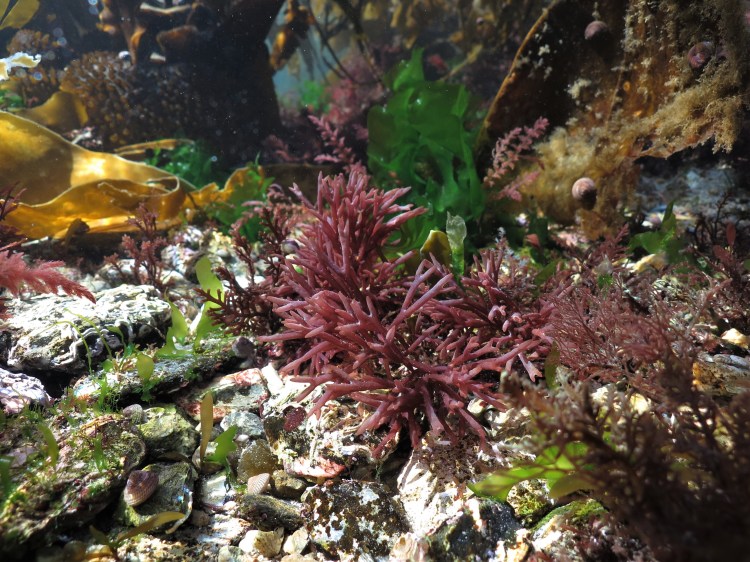
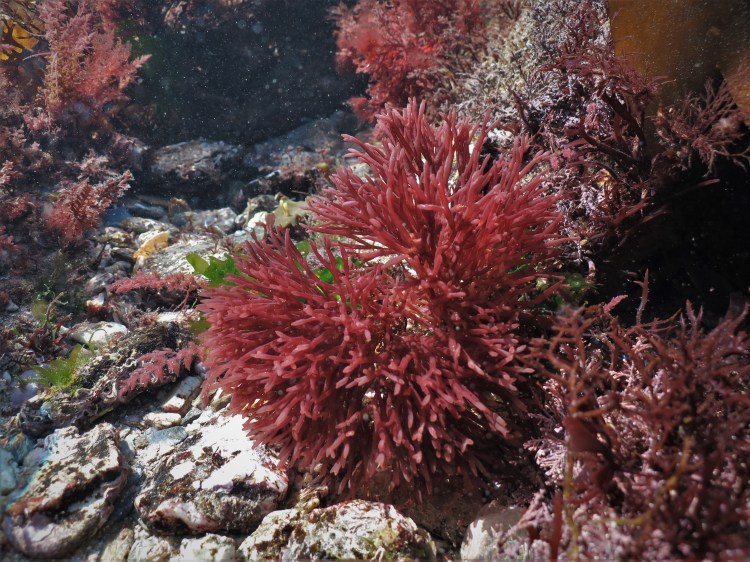

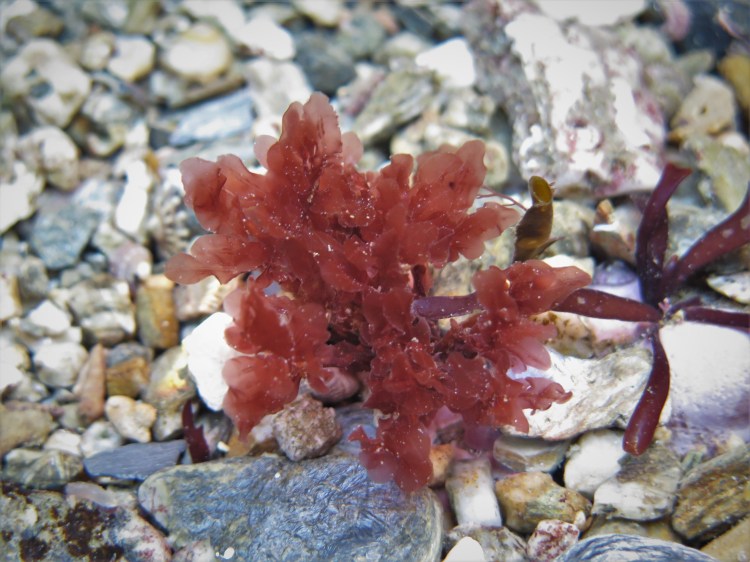

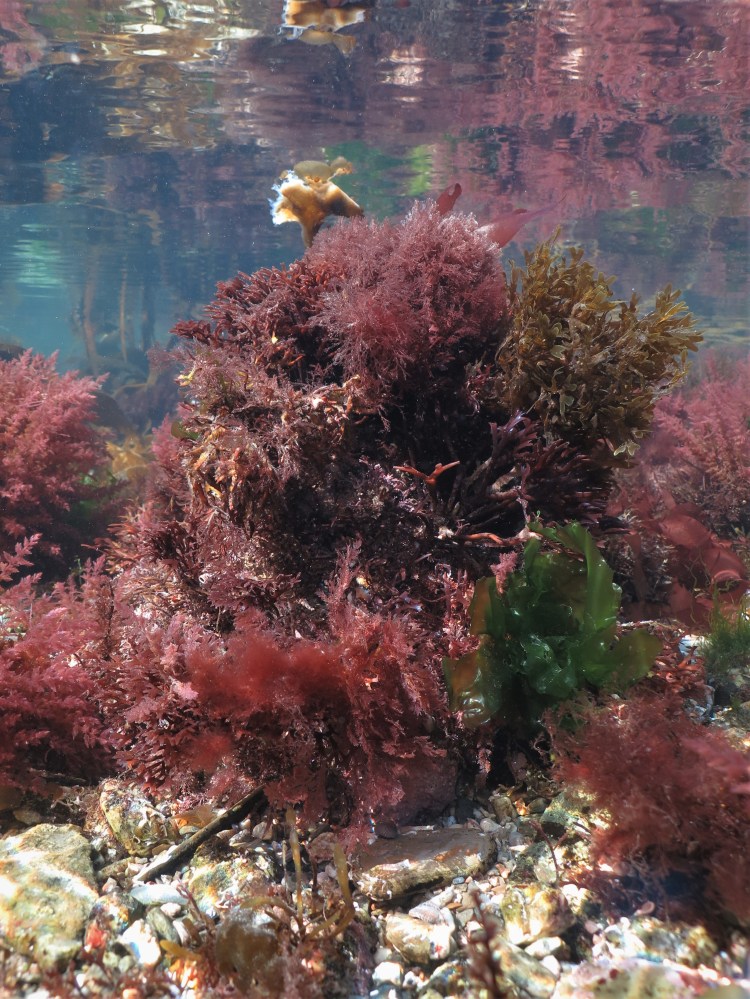
Falmouth Seaweeds (and fish) June
 I have been diving three times last week but due to internet problems have not posted about them. I hope to do that in the coming days, but first wanted to blog about this mornings snorkel session in the shallow rock pools at Castle Beach in Falmouth, as I experienced the best viz (visibility) ever here. Apart from the stunning viz, I was very lucky with the fish: I spotted a Tompot blenny, Two-spot Gobies, Fifteen-spined stickleback, Rock goby, Pollack, Ballan-, Corkwing- and Goldsinny Wrasse and Sand eels (above and below). However, I mainly wanted to check what the seaweeds looked like, and things have definitely changed over the last month (see here).
I have been diving three times last week but due to internet problems have not posted about them. I hope to do that in the coming days, but first wanted to blog about this mornings snorkel session in the shallow rock pools at Castle Beach in Falmouth, as I experienced the best viz (visibility) ever here. Apart from the stunning viz, I was very lucky with the fish: I spotted a Tompot blenny, Two-spot Gobies, Fifteen-spined stickleback, Rock goby, Pollack, Ballan-, Corkwing- and Goldsinny Wrasse and Sand eels (above and below). However, I mainly wanted to check what the seaweeds looked like, and things have definitely changed over the last month (see here). The Wireweed Sargassum muticum and Spaghetti (or Thong) weed Himanthalia elongata are thriving and at low tide hang over the surface creating ‘tunnels’. The Harpoonweed below is in decline, turning from pink to yellow-white (and the Bonnemaisonia is almost completely gone). The fronds of the False eyelash weed have turned from juicy and red-brown to wiry and yellow and the corraline algae are turning white. The Sea lettuce Ulva has died back and is covered in speckles (sporangia?).
The Wireweed Sargassum muticum and Spaghetti (or Thong) weed Himanthalia elongata are thriving and at low tide hang over the surface creating ‘tunnels’. The Harpoonweed below is in decline, turning from pink to yellow-white (and the Bonnemaisonia is almost completely gone). The fronds of the False eyelash weed have turned from juicy and red-brown to wiry and yellow and the corraline algae are turning white. The Sea lettuce Ulva has died back and is covered in speckles (sporangia?). 


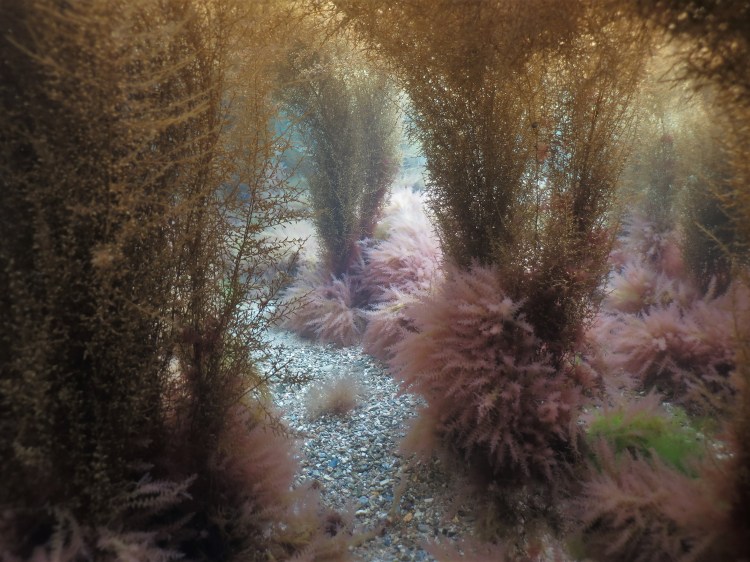

 Some epiphytes are thriving, the very fuzzy brown Pylaiella littoralis covers kelp, a Ceramium species grows as pompoms on the Spaghettiweed. One pink and fuzzy species that is growing well I should have taken a closer look at because I am not sure what it is now (I will enquire at the Seaweeds of the NE Atlantic facebook group). The next species I think I can identify: Chipolataweed Scytosiphon lomentaria. The Bushy rainbow wrack Cystoseira tamariscifolia looks fuzzier and greyer than before. Although with less species and more subdued colours, the pools still look beautiful, and I hope the good visibility will last a bit longer!
Some epiphytes are thriving, the very fuzzy brown Pylaiella littoralis covers kelp, a Ceramium species grows as pompoms on the Spaghettiweed. One pink and fuzzy species that is growing well I should have taken a closer look at because I am not sure what it is now (I will enquire at the Seaweeds of the NE Atlantic facebook group). The next species I think I can identify: Chipolataweed Scytosiphon lomentaria. The Bushy rainbow wrack Cystoseira tamariscifolia looks fuzzier and greyer than before. Although with less species and more subdued colours, the pools still look beautiful, and I hope the good visibility will last a bit longer!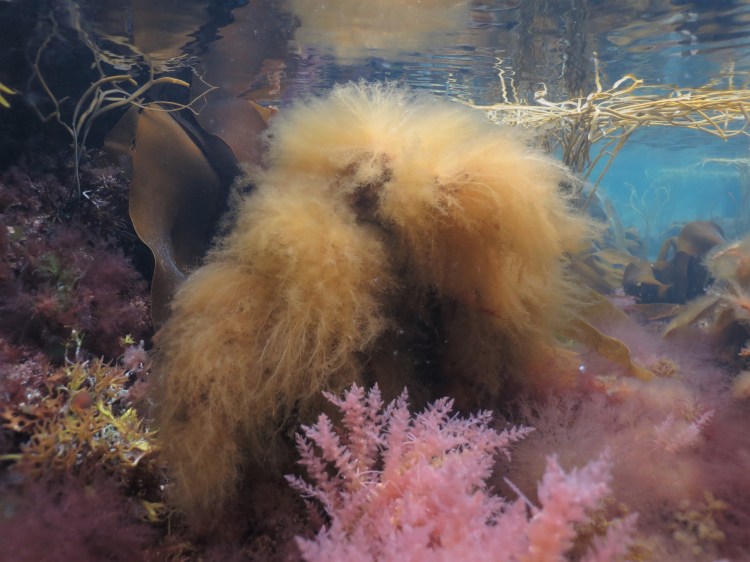
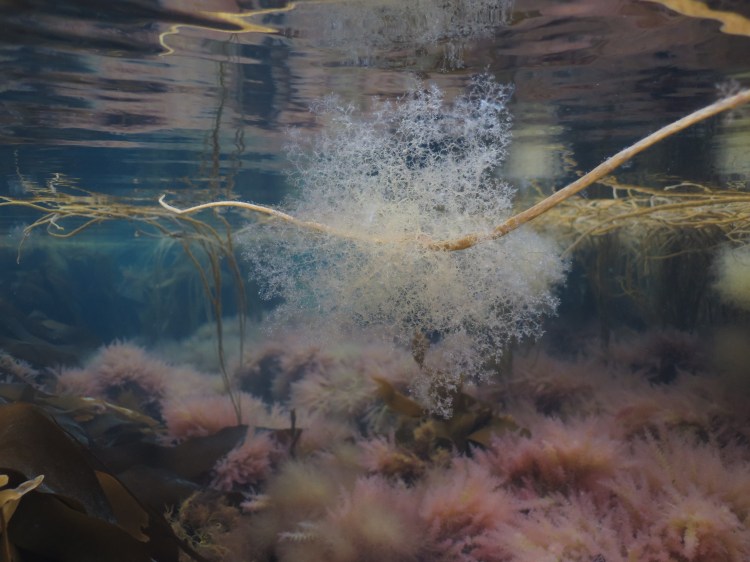
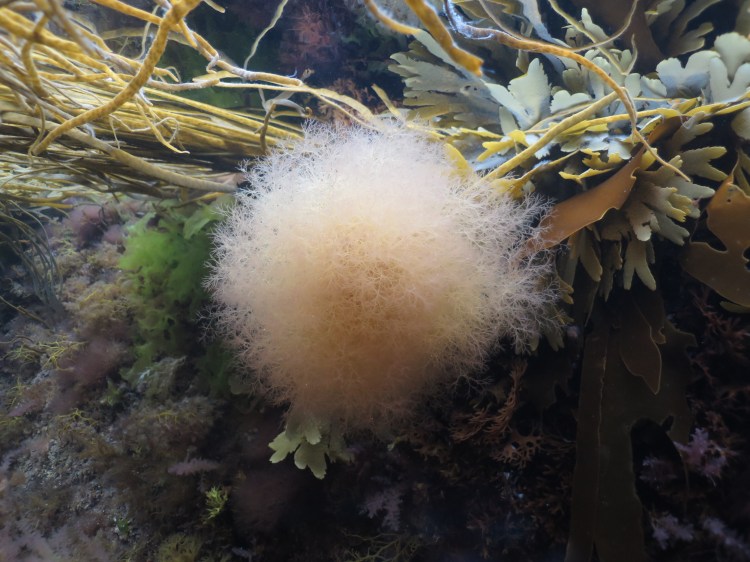

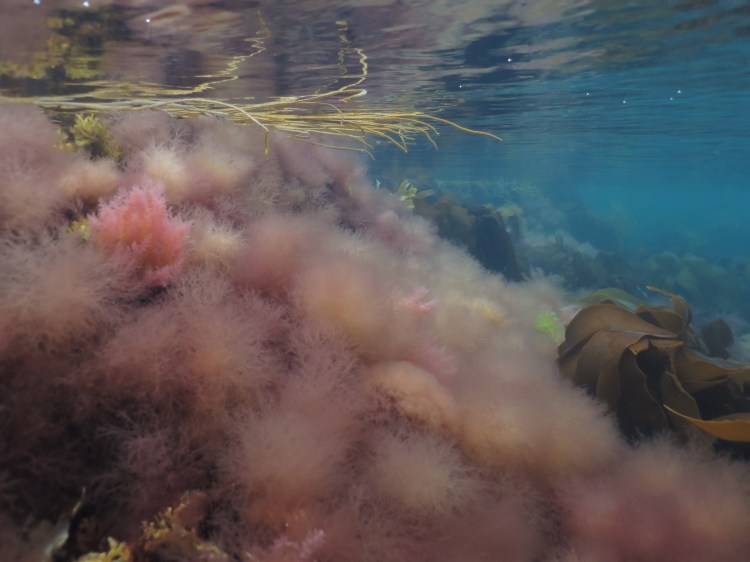
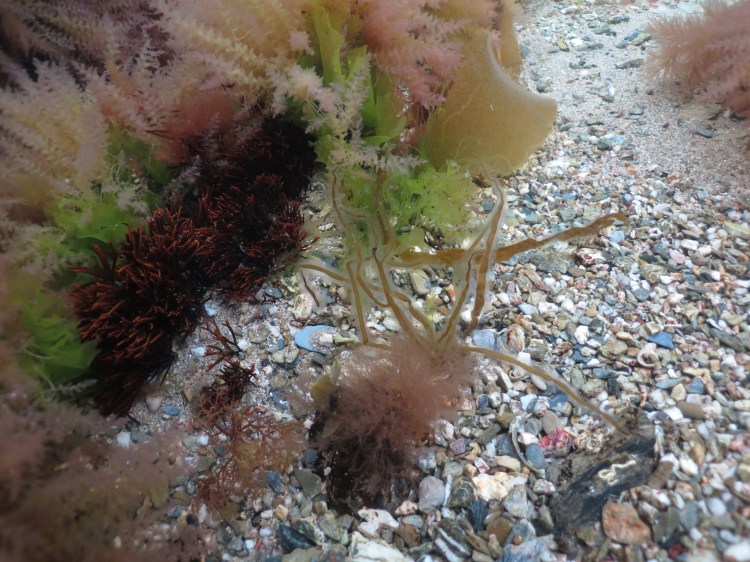


First Dive of 2017
 Finally, time for a (solo)dive last Saturday, at probably the most accessible local site: Silver Steps in Falmouth (you can just make out the steps in the photo above). The sun and high tide had attracted quite a lot of other divers too, including University of Exeter and Falmouth University students learning the ropes. I was very keen to get in the water and take photos but my approach is probably not the best: I just shoot whatever happens to be in front of me. Better results could be obtained to specifically look for macro subjects, to stay in the water column and search for jellies, befriend the Ballan wrasse or stay put in front of a Leopard-spotted goby hide-out (or check out seaweeds of course). I’ll do one of these things next time, for now, some random shots. I spotted several Spider crabs; these are always shy and try to quickly retreat, except for one. This big crab came after me as soon as we spotted each other. I should have tried more shots, as unfortunately he did not fit the frame. You can see in the short movie why I didn’t!
Finally, time for a (solo)dive last Saturday, at probably the most accessible local site: Silver Steps in Falmouth (you can just make out the steps in the photo above). The sun and high tide had attracted quite a lot of other divers too, including University of Exeter and Falmouth University students learning the ropes. I was very keen to get in the water and take photos but my approach is probably not the best: I just shoot whatever happens to be in front of me. Better results could be obtained to specifically look for macro subjects, to stay in the water column and search for jellies, befriend the Ballan wrasse or stay put in front of a Leopard-spotted goby hide-out (or check out seaweeds of course). I’ll do one of these things next time, for now, some random shots. I spotted several Spider crabs; these are always shy and try to quickly retreat, except for one. This big crab came after me as soon as we spotted each other. I should have tried more shots, as unfortunately he did not fit the frame. You can see in the short movie why I didn’t!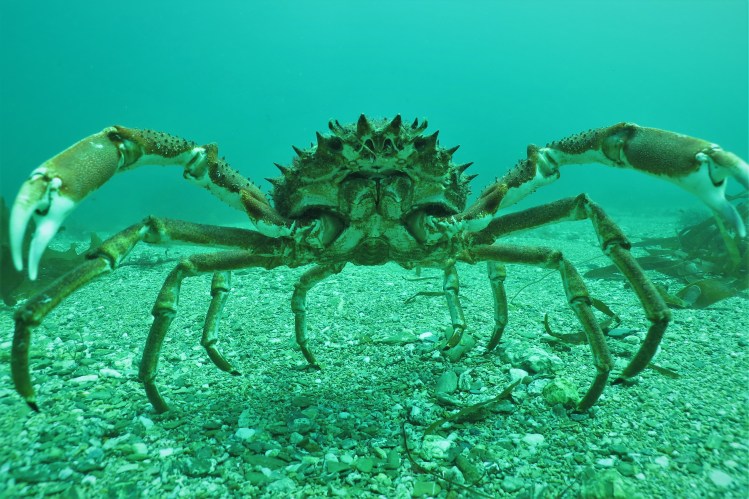
The viz was not great (I find it hard to estimate it in meters though). In the water I noticed a small hydrozoan Leuckartia octona. The underside of some wreckage harboured Light bulb sea squirts (see previous post) and some were predated on by Candy striped flatworm Prostheceraeus vittatus. (I brought my new LED light with me to help bring some colour out but I just ended up with combinations of glare and shadows so stuck to my normal natural light pics.) Next, a curious Ballan wrasse Labrus bergylta. Finally, some not so clear shots that nevertheless give a good impression of how tall the invasive Wireweed Sargassum muticum are growing. Hopefully more dive posts soon!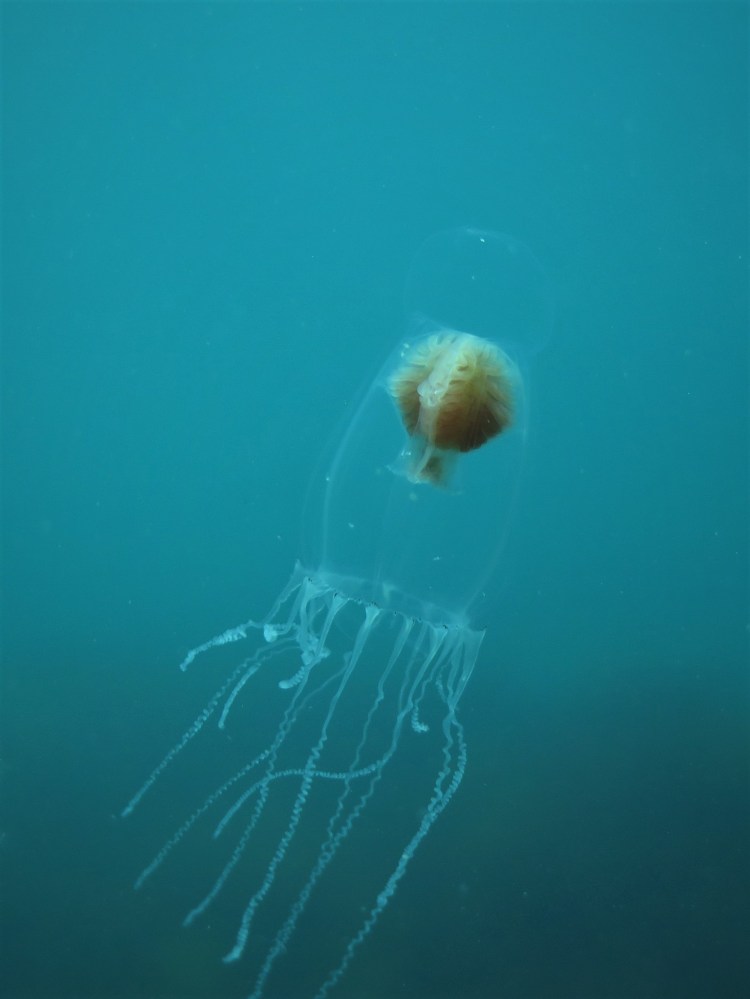
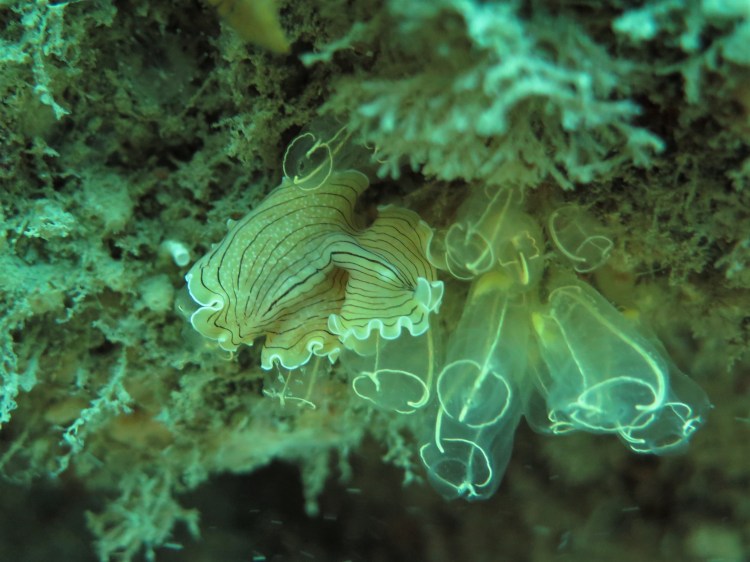
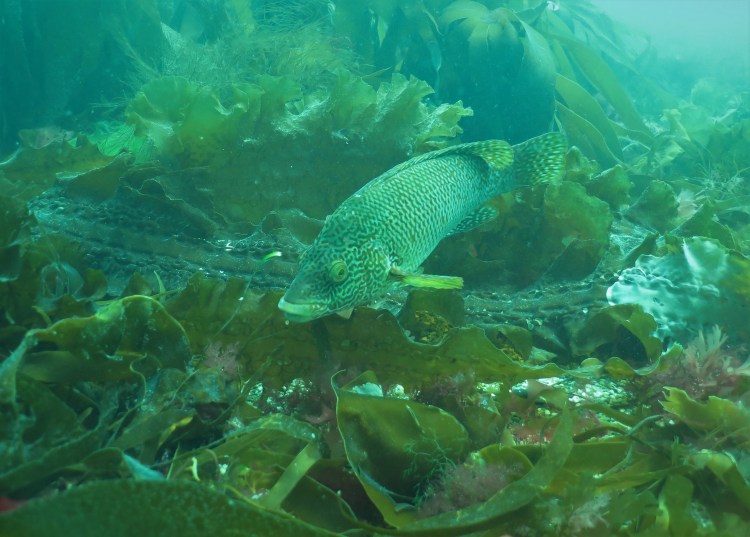


photographing seaweeds with a Canon Powershot part V
I have been a bit busy and so the photos below are some weeks old. The seaweeds are in decline already it seems. Actually, that is not true, there are plenty of seaweeds growing, but some of the prettier ones are dying off and some of the uglier ones are taking over. The window to take the nicest rock pool shots is quite short, pretty much early spring only. The ubiquitous False eyelash weed Calliblepharis jubata is yellowing, the green Sea lettuce Ulva lactuca is starting to cover everything and the Red grape weed is getting ‘fluffy’. Not the best session photo quality-wise and probably the last of the year. The Bushy rainbow wrack Cystoseira tamariscifolia is abundant and looking good (on the photo with Discoid forkweed Polyides rotundus) and I managed I nice shot of young Thong (or Spaghetti) weed Himanthalia elongata. I have done some more research into ‘proper’ underwater cameras and was tipped of about the Canon G16 (thanks Thomas from HydroMotion Media), maybe something for next year….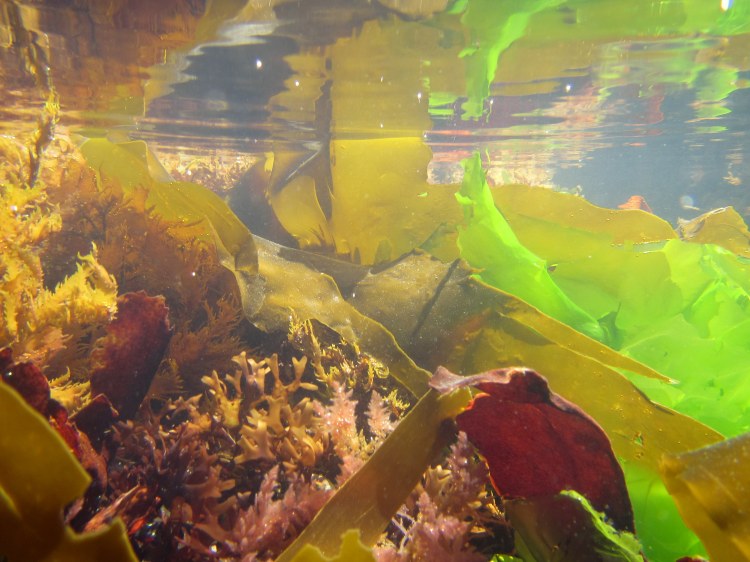



 The past couple of times when focusing on the seaweeds I also encountered some animals (it is hard not to). Many Snakelocks anemones Anemonia viridis, with some having very short tentacles. Next, a Decorator crab Macropodia rostrata covered in Banded pincer weed Ceramium. Mermaid’s purses (egg cases) of the Bull huss/Greater-spotted Dogfish/Large-spotted Catshark/Nursehound Scyliorhinus stellaris seem to be exclusively attached to Bushy rainbow wrack. Finally, a Stalked jellyfish Haliclystus octoradiatus on Wireweed Sargassum muticum.
The past couple of times when focusing on the seaweeds I also encountered some animals (it is hard not to). Many Snakelocks anemones Anemonia viridis, with some having very short tentacles. Next, a Decorator crab Macropodia rostrata covered in Banded pincer weed Ceramium. Mermaid’s purses (egg cases) of the Bull huss/Greater-spotted Dogfish/Large-spotted Catshark/Nursehound Scyliorhinus stellaris seem to be exclusively attached to Bushy rainbow wrack. Finally, a Stalked jellyfish Haliclystus octoradiatus on Wireweed Sargassum muticum.
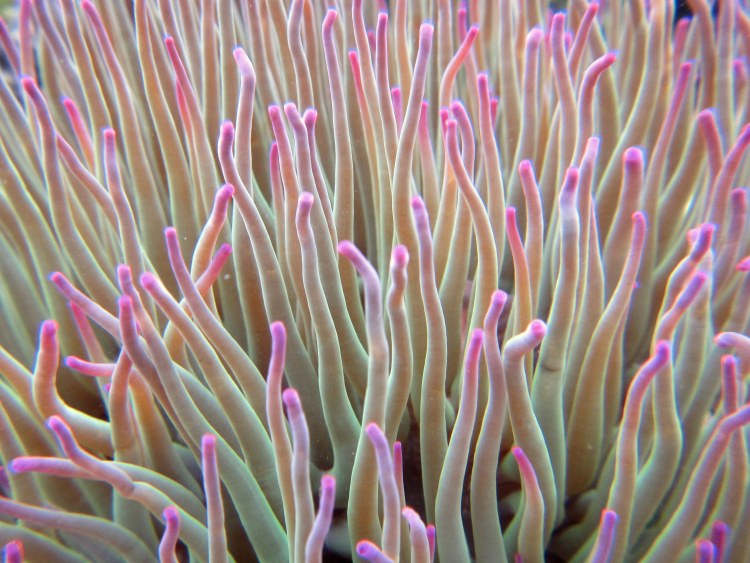


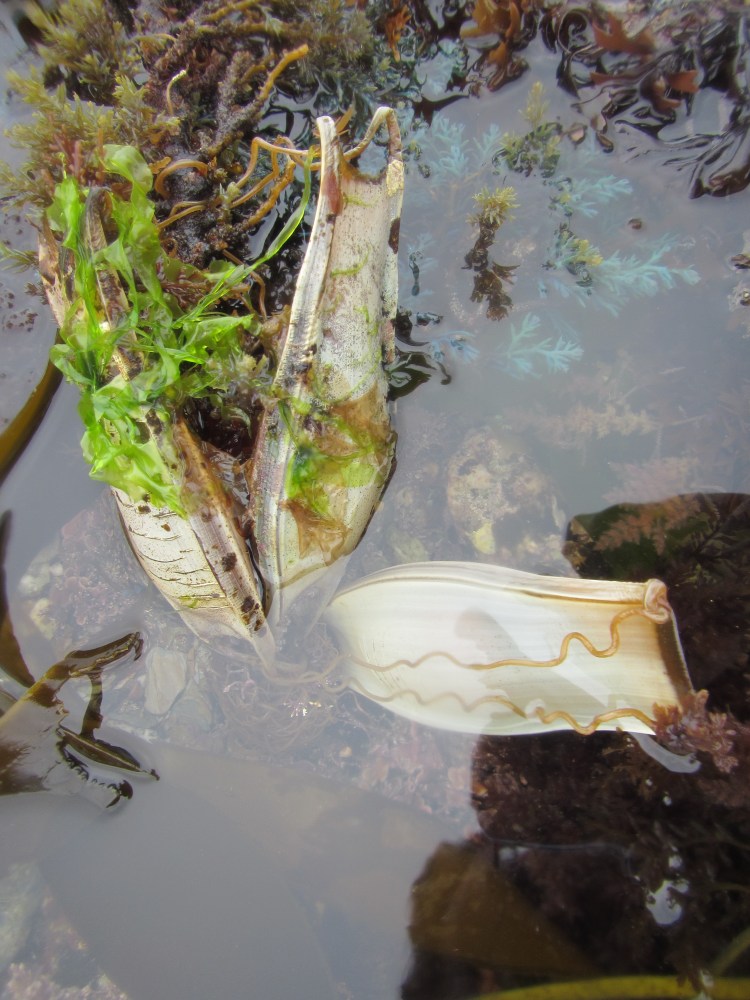


Leftover Pics
When going out rock pooling, I always take my iPhone and Canon Powershot (for underwater use) and take at least a couple of photos. Because of a lack of time, or because a single good photo is not enough for a new post, not everything ends up on the blog. Now I have some free time, I picked a couple of unused photos made this year that seem blog-worthy. First up, In realized only what I had found on the beach at St. Ives when leafing through the The Essential Guide to Beachcombing and the Strandline: a Seabeard! This hydroid, Nemertesia antennina, grows as stiff colonies protruding from a matted base and occasionally washes up on shore. It looks a bit plant-like; at the time I did not have the opportunity to have a closer look and just snapped a quick photo. Next a Lesser sandeel Ammodytes tobianus found at Gylly beach. I always see them when snorkeling or diving (see here) but this was a good opportunity to see one up close (I get excited when I spot a dead fish on the beach (see also here) and I am not afraid to admit it!). 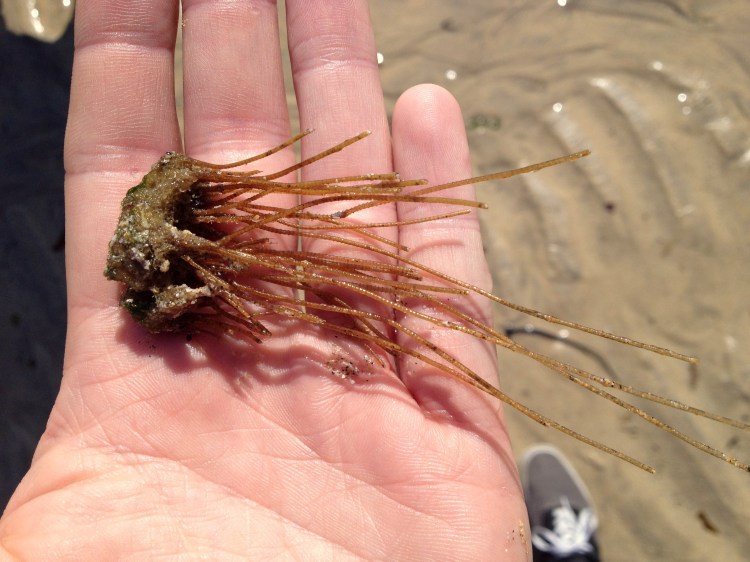

 Following are two colour varieties of the Spiny starfish Marthasterias glacialis, a Common brittlestar Ophiothrix fragilis and a shot of an Aequorea forskalea (or maybe A. vitrina) jellyfish. Next the gastropod mollusc Chinaman’s hat Calyptraea chinensis. I went back to Mylor marina for some pontooning recently but not much was growing; the only thing that stood out was the luxuriant sponge growth (I am not sure of the species, perhaps Halichondria).
Following are two colour varieties of the Spiny starfish Marthasterias glacialis, a Common brittlestar Ophiothrix fragilis and a shot of an Aequorea forskalea (or maybe A. vitrina) jellyfish. Next the gastropod mollusc Chinaman’s hat Calyptraea chinensis. I went back to Mylor marina for some pontooning recently but not much was growing; the only thing that stood out was the luxuriant sponge growth (I am not sure of the species, perhaps Halichondria).
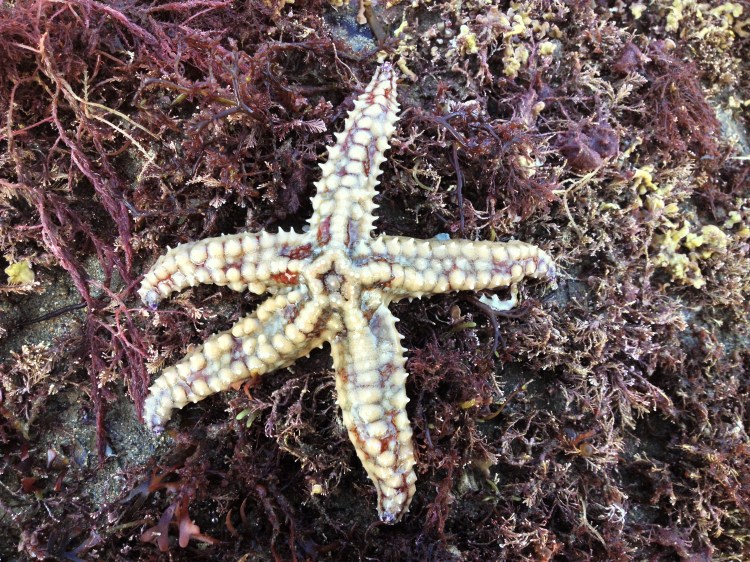



 And of course some seaweed pictures. By iPhone: Under tongue weed Hypoglossum hypoglossoides in Flushing, Black scour weed Ahnfeltia plicata in St. Agnes and a photo showing a variety of wracks all colonizing the same patch (Flushing): Serrated wrack Fucus serratus, Spiraled wrack Fucus spiralis, Bladderwrack Fucus vesiculosis and Egg wrack Ascophylum nodosum. Next some Canon Powershot underwater pics (see also this post and this one): a random rock pool picture of mostly decaying seaweed, a closeup of my favourite the Bushy rainbow wrack Cystoseira tamariscifolia and a shot of Wireweed Sargassum muticum that has completely taken over a pool. Finally an SLR photo of a rock pool at Gylly beach with large Cystoseira baccata plants (middle, Wireweed on the left).
And of course some seaweed pictures. By iPhone: Under tongue weed Hypoglossum hypoglossoides in Flushing, Black scour weed Ahnfeltia plicata in St. Agnes and a photo showing a variety of wracks all colonizing the same patch (Flushing): Serrated wrack Fucus serratus, Spiraled wrack Fucus spiralis, Bladderwrack Fucus vesiculosis and Egg wrack Ascophylum nodosum. Next some Canon Powershot underwater pics (see also this post and this one): a random rock pool picture of mostly decaying seaweed, a closeup of my favourite the Bushy rainbow wrack Cystoseira tamariscifolia and a shot of Wireweed Sargassum muticum that has completely taken over a pool. Finally an SLR photo of a rock pool at Gylly beach with large Cystoseira baccata plants (middle, Wireweed on the left).


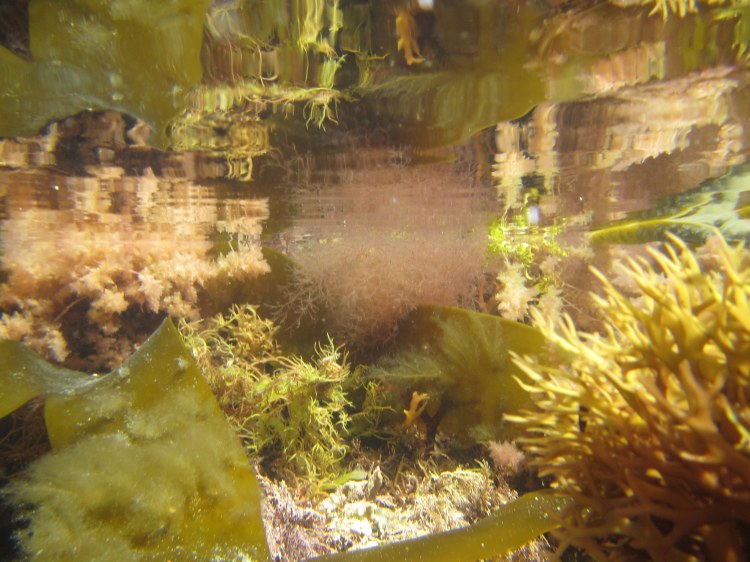

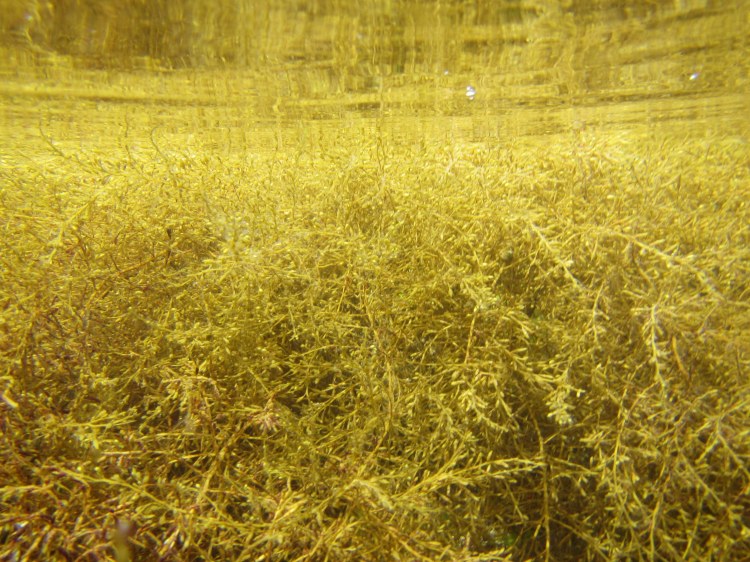

a tiny rock pool
Last weekend I went down to Gylly Beach in Falmouth for a bit of rock pooling. However, the tide was not very low (especially with the inshore wind) and the weather was crap. Moreover, I could not find anything that I had not seen many times before; although rock pool life is very biodiverse, there have started to be dimishing returns when looking for non-microscopic organisms. Clambering over yet another rock, I decided to stop and play around with my Canon Powershot instead. I focused on a tiny pool (around two by four feet) completely covered in corraline algae.  It does not look like much but taking the time for a carefully look was really rewarding. It is tricky to take photographs without being able to see the viewfinder though. My strategy has been to just take loads of pictures and hope some of them work out. The miniature underwater landscape was really beautiful. Pink plates Mesophyllum lichenoides made up the largest proportion of corraline algae (some bearing ‘reproductive conceptacles’). Another species is Corallina officinalis or Common coral weed (third photo). I had some Corallina growing in my aquarium at some point, but it grew very slowly and has now disappeared. Being able to create the right conditions for coralline algae to thrive in a coldwater aquarium would be fantastic, but I have not seen any evidence of anyone being able to cover their aquarium in them yet. (I have tried ‘planting’ Corallina and although it looked very nice at first (fifth pic), these seaweeds quickly died off, turning orange and then white (second pic).)
It does not look like much but taking the time for a carefully look was really rewarding. It is tricky to take photographs without being able to see the viewfinder though. My strategy has been to just take loads of pictures and hope some of them work out. The miniature underwater landscape was really beautiful. Pink plates Mesophyllum lichenoides made up the largest proportion of corraline algae (some bearing ‘reproductive conceptacles’). Another species is Corallina officinalis or Common coral weed (third photo). I had some Corallina growing in my aquarium at some point, but it grew very slowly and has now disappeared. Being able to create the right conditions for coralline algae to thrive in a coldwater aquarium would be fantastic, but I have not seen any evidence of anyone being able to cover their aquarium in them yet. (I have tried ‘planting’ Corallina and although it looked very nice at first (fifth pic), these seaweeds quickly died off, turning orange and then white (second pic).)

 Some other seaweed species were present as well; Irish moss and Harpoonweed (not pictured), False eyelash weed Calliblepharis jubata occurred in multiple patches, Rhodophyllis divaricata?, an Osmundea species and Red grape weed Gastroclonium ovatum. There were also a few brown seaweeds, the characteristic Thong (or Spaghetti) weed Himanthalia elongata buttons and the invasive (and pervasive) Wireweed Sargassum muticum.
Some other seaweed species were present as well; Irish moss and Harpoonweed (not pictured), False eyelash weed Calliblepharis jubata occurred in multiple patches, Rhodophyllis divaricata?, an Osmundea species and Red grape weed Gastroclonium ovatum. There were also a few brown seaweeds, the characteristic Thong (or Spaghetti) weed Himanthalia elongata buttons and the invasive (and pervasive) Wireweed Sargassum muticum.




 I did not spot too many animals, although I am sure there is an enormous hidden diversity present among the seaweeds. I noticed a red-white Dahlia anemone Urticina felina as well as some patches of a colonial brown tunicate. I’d like to go back soon and take some more pictures, with my Canon powershot or with my GoPro. I have an SLR as well that I have not been using lately as my iPhone is such a good camera and hassle-free. SLR underwater housings are really expensive, but I recently discovered that there are quite cheap waterproof SLR bags available which might be an option to try to take higher quality photos (in rock pools, I would not go diving or snorkeling with them). It would be very cool to try to make panorama pictures of rock pools, especially when taking one each month in the same spot to capture seasonality. More seaweed photos, Canon powershot or otherwise, to follow soon!
I did not spot too many animals, although I am sure there is an enormous hidden diversity present among the seaweeds. I noticed a red-white Dahlia anemone Urticina felina as well as some patches of a colonial brown tunicate. I’d like to go back soon and take some more pictures, with my Canon powershot or with my GoPro. I have an SLR as well that I have not been using lately as my iPhone is such a good camera and hassle-free. SLR underwater housings are really expensive, but I recently discovered that there are quite cheap waterproof SLR bags available which might be an option to try to take higher quality photos (in rock pools, I would not go diving or snorkeling with them). It would be very cool to try to make panorama pictures of rock pools, especially when taking one each month in the same spot to capture seasonality. More seaweed photos, Canon powershot or otherwise, to follow soon!

first dive in Cornwall
A couple of weeks ago I went for a bit of a spur of the moment after-work dive with colleague Andrew (like me a quite unexperienced diver) and his friend Charlotte Sams. Charlie is an experienced diver and natural history photographer, who has her own blog: Charlottesamsphotography, which you should check out. We dove in Falmouth off Pendennis point. The water was not very clear (maybe 5-6 meters visibility) but the temperature was quite nice. We saw (amongst others) Sand eels (do not know which of the two species), Pollack Pollachius pollachius, Dragonets Callionymus lyra, Two-spotted gobies Gobiusculus flavescens, a Tompot blenny Parablennius pararugine, very large Ballan wrasse Labrus bergylta and a beautiful little John dory Zeus faber:
We also saw some very large Common starfish Asteria rubens and also a nice Spiny starfish Marthasteria glacialis. We dove only to about 5-7 meters, which meant we could stay in quite long, over an hour. At seven meters, the bottom was a sandy expanse, interspersed with mounts of Laminaria Kelp covered in hydroids. In-between the kelp were other seaweeds, such as Red rags Dilsea carnosa but I was more focused on the animals during the dive. In shallower water were enormous bundles of Wireweed Sargassum muticum (also known as japweed but that is not very pc…) and the very long slimy Mermaid’s tresses or Bootlace weed Chorda filum. Snakelocks anemones were very common, and we managed to also see Leach’s spider crab Inachus phalangium, which lives associated with these anemones. All in all a fantastic experience, and I hope to find the time to go diving very soon again!
Grevelingen
Two weekends ago I was back in The Netherlands for a short visit. The weather was great and we drove in my sisters camper van to the Brouwersdam, connecting the provinces of Zuid-Holland and Zeeland. This dam was built in 1971 and created the largest saltwater lake in Western Europe: the Grevelingen. We first stopped at the North Sea side of the dam though. This is spot is very popular with kite surfers, windsurfers and blokarters, with loads of people travel all the way from Germany even. Although great for sports, the Dutch coast is not the best place for a rock pool hunter (an bollenessor!) such as myself. The Brouwersdam provides hard substrate along an otherwise sandy coast, but there are no true rock pools and relatively few species of seaweed (mainly wracks and Ulva), some mussels and periwinkles and not much else:
However, this seaweed looked interesting (I also found it in Bretagne recently), but I just cannot get it identified, any suggestions?
*edit* commenter Edwin reckons Chordaria flagelliformis and this was indeed the page in my Seaweeds of Britain and Ireland where I lingered longest, I think he is right!
On the way back we stopped at the Grevelingen side. The Grevelingen is an unusual place: the water is salty, but there are no tides. There is only a very limited connection to the North Sea and so little water movement, which creates stratification and anoxic conditions in deeper waters, resulting in a ‘dead zone’. In shallower water there is plenty of life though (check this site for instance). We waded on mud through very clear water to have a quick look (mud is not stirred up by any current and the lack of any inflowing rivers keep the water relatively nutrient poor en algae-free) . There were many Shore crabs about, and they were quite aggressive, trying to pinch my toes:
I saw that Wireweed Sargassum muticum is very common here as well (see also this post and this post). These very large plants were colonized by fine red seaweeds and lots of Mysis shrimp were hiding underneath them:
I also stopped by the natural history museum in Rotterdam that I have been a member of over half of my life. I noticed that in their permanent ‘Biodiversity’ exhibition that there was a shelf dedicated to seaweeds. Of course they deserve a place in such an exhibit, but I must admit that they look a whole lot more interesting in the sea than dried or in alcohol/formalin.
Bretagne: Erquy
Last week we crossed the channel to attend a friend’s wedding in Bretagne (Brittany). This of course also called for some rock pooling action, first at the village of Erquy. It was interesting to compare the shores of Bretagne to Cornwall (or at least Falmouth and this small stretch of coast in northern Bretagne). Immediately noticeable was the large amount of oysters on the rocks (with some locals busy collecting them, quelle surprise); these are pretty much absent in Falmouth:
Similar to the Cornish coast, wireweed Sargassum muticum was abundant. This Pacific invader surely must have a large effect on the native flora and fauna:
Invertebrate diversity was strikingly low compared to my local rock pools. For example, the only fish to be found were Shannies (and not a lot of them), there were no Cushion stars and no large crustaceans except for the shore crab. However, we did find a Common spider crab Maja squinado:
 As there was not that much to see, I turned my attention to some of the less spectacular life forms, such as Pink paint weeds, red algae forming a calcified crust. The particular species pictured below forms a patchwork of individuals, crinkling up at the edges where they meet. This could be Litophyllum incrustans, but species are hard to identify by non-specialists such as myself. The little spots on the surface are the openings of reproductive structures called conceptacles.
As there was not that much to see, I turned my attention to some of the less spectacular life forms, such as Pink paint weeds, red algae forming a calcified crust. The particular species pictured below forms a patchwork of individuals, crinkling up at the edges where they meet. This could be Litophyllum incrustans, but species are hard to identify by non-specialists such as myself. The little spots on the surface are the openings of reproductive structures called conceptacles.
 The European sting winkle Ocenebra erinacea was quite abundant and distinctive vase-shaped egg cases could also be found:
The European sting winkle Ocenebra erinacea was quite abundant and distinctive vase-shaped egg cases could also be found:










